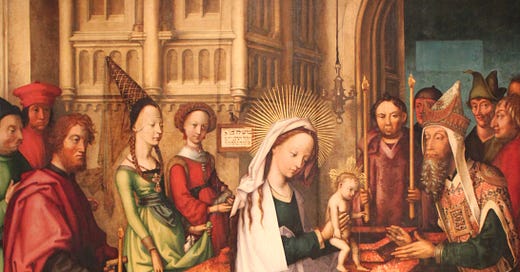Now that the new year is well underway, we can finally declare that Christmas is over – for real this time. Most churches take down all of their Christmas decorations by Candlemas, which falls on February 2nd. Also known as the Feast of the Presentation of Jesus Christ, the Feast of the Purification of the Blessed Virgin Mary AND the Feast of the Holy Encounter, you have have surmised that this is a lesser Christian feast day celebration.
The rules for living laid out by the Old Testament can sometimes be rather strange. According to Leviticus 12, the mother of a boy was to be considered “unclean” for 7 days, and remain in a state of blood purification for an additional 33. (If the child was a girl, the period extended to 14 and 66 days.) After these 40 days, the mother would take a sin offering to the temple to be burnt by the priest, and she would be declared “clean” – unless she had a weird rash or something, which the priest might take exception to.
The ideal sacrifice was a lamb, obviously. But as those could be expensive, two doves or pigeons would be acceptable. The scripture points out that Joseph and Mary took the poor folks’ route, highlighting the humble home Jesus was born into.
The Book of Luke suggests that Mary and Joseph used this trip to also perform the ritual known as the redemption of the firstborn son – doubling up, very economical. In this rite preformed before a quorum of Jewish men, five shekels (or equivalent silver) would be paid to an Aaronic priest in exchange for a true firstborn son because, “(As it is written in the law of the Lord, Every male that openeth the womb shall be called holy to the Lord;)” Sons born following the birth of a daughter, after a miscarriage or via caesarian apparently don’t count.
This is important because it 1.) underscores that Jesus was seen as inherently holy and set apart from other tots in their faith and 2.) ensured that Jesus would have the audience of important figures of the community. And indeed, two important people saw him at the temple and dropped prophesies that Jesus was, in fact, the redeemer that they had all been waiting for. So it was kind of a big day for an infant, all around.
With absolutely no idea what time of year Jesus was born, we also have absolutely no idea when this presentation happened. When the date of Christmas was fixed, so was the date of Candlemas. Conspiracy theorists said that this was an attempt to erase Lupercalia, which also celebrates purification and fertility (more on that later.)
What’s up the the candles? A common theme of late autumn and winter celebrations is the power of light in the long nights. By the fifth century, candles became an important piece of these feast day services. First, priests would bless and distribute candles for the mass; eventually, this morphed into members bringing their candles to be blessed for use throughout the year. The name Candlemas was less of a mouthful than the other lengthy feast day titles, and it also provided a nice bookend to the Christmas season.
Since it officially ends (for real) the Christmas and Epiphany season, many traditional celebrations treat Candlemas as New Year’s Day or, as in Germany, the beginning of the “farmer’s year.” In many countries, the weather on Candlemas is seen as a portent of things to come (more on that later!) Likewise, the length of time candles remain burning are viewed as good or bad luck, depending.
Speaking of Gelasius, he had a tradition of delivering pancakes to pilgrims arriving in Rome. Because of him, Candlemas is known as the day of crêpes or pancakes in a few countries. In France and Belgium, it’s traditional to flip your crêpes in the air with the right hand while holding a coin in the left, to symbolize prosperity in the coming year. In Mexico, meanwhile, tamales are the order of the day; whoever drew the bean from the king cake at Epiphany must make these treats for the family meal following a pageant recreating the presentation of Christ.





